Keeping The Noise Out
When you live in an apartment, noise is everywhere. Noise reflects from hard surfaces, like walls, floors, and ceilings—adding to the overall noise level inside a room. With all the turmoil in our world, a safe and quiet apartment home is vital. Follow me in this 3-part series of How to Keep Apartment Units Quiet.
Before you can solve your sound-pollution problem, you need to understand STC ratings. So, to kick off this series, today I give you STC Ratings—simplified.

What is an STC Rating
 Sound Transmission Class (STC) is the measurement used to calculate the efficiency of soundproofing materials in reducing the sound spread between rooms. In the United States, it is widely used to rate interior partitions, ceilings and floors, doors, windows, and exterior wall configurations. Sound vibration decreases as it travels from one side of a wall to the other.
Sound Transmission Class (STC) is the measurement used to calculate the efficiency of soundproofing materials in reducing the sound spread between rooms. In the United States, it is widely used to rate interior partitions, ceilings and floors, doors, windows, and exterior wall configurations. Sound vibration decreases as it travels from one side of a wall to the other.
How the rating works: STC is a rough measure of the decibel reduction in noise. Noise reduction depends on frequencies, which—when calculated—shows us the approximate measure of how well materials absorb sound. The higher the STC rating, the better the sound-absorbing quality.
The International Building Code requires an STC of 50 for multifamily construction, which is the point at which noise is reduced so that people generally feel like their homes are adequately insulated from noise. It is also the point at which respondents to surveys begin a drastic reduction in noise-related complaints. A higher STC rating means better soundproofing. The table below puts these numbers into perspective.

Did you know
- Sound vibrations travel between rooms at vulnerable points, such as through ductwork, plumbing, and hallways.
- Sound can travel over, around, and underneath various materials, doors, and vents.
- Air gaps between apartment walls provide sound insulation. (This means the modular design can be a great solution to noise—more to come on this next week).
- Your window’s STC rating is important—a standard, single-pane window offers an STC rating in the range of 26-28, and you can add a few points with well-constructed dual pane windows.
- The ideal STC rating depends on the application and outside factors that may contribute to any interference.
![]() Quiet apartments mean happy tenants. Happy tenants mean fewer complaints for owners.
Quiet apartments mean happy tenants. Happy tenants mean fewer complaints for owners. ![]()
Stay tuned for next week when we offer ideas to help you improve your STC ratings. In the meantime, don’t forget to check out STONEPILE llc, The Online Construction College, where students excel in all the latest IC technologies, building toward the future.

Thank you,
Blair Hildahl
BASE4 Principal
608.304.5228
BlairH@base-4.com
![]()
Source:




